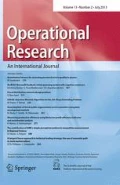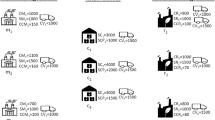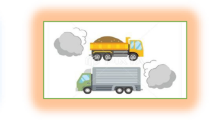Abstract
This paper studies a production system, which combines product remanufacturing and the original production. The analysis tool employed is the System Dynamics (SD) methodology. Specifically, using SD a dynamic model of a dual system (forward and reverse supply chain) is built. The system includes production, remanufacturing, consumption and disposal of used products. The dynamic model is used to study the system behavior under external influences, such as the environmental legislation and investments on remanufacturing facilities. These influences are examined both during the transient and the steady state. Using the model, it is possible to evaluate alternative strategies and to determine the optimal one towards the objectives.
Similar content being viewed by others
References
Coyle, R.G., (1996). System Dynamics Modelling: a Practical Approach, Chapman & Hall, London.
Fleischmann M., (2000). Quantitative models for reverse logistics, PhD thesis, Erasmus University Rotterdam.
Fleischmann, M., Jacqueline, M.B.-R., Dekker, R., van der Laan, E. A., van Numen, Jo. A.E.E. and van Wassenhove, L. N., (1997). Quantitative models for reverse logistics: A review, European Journal of Operational Research vol.103, 1–17.
Fleischmann, M., Krikke, R. H., Dekker, R. and Flapper, S. D. P., (2000). A characterisation of logistics networks for product recovery, Omega vol. 28, 653–666.
Forrester, J.W., (1961). Industrial dynamics, MIT Press, Cambridge, MA.
Forrester, J.W., (1980). Principles of Systems, MIT Press, Massachusetts.
Georgiadis, P. and Vlachos, D. (2004A). The effect of environmental parameters on product recovery. European Journal of Operations Research vol. 157, 449–464.
Georgiadis, P., Tagaras, G. and Vlachos, D. (2004B). Long-term Analysis of Closed-loop Supply Chains in. Reverse Logistics, (Dekker R., Fleischmann M. and Van Wassenhove L. N. ed,). Springer-Verlag, 313–331.
Georgiadis, P., Vlachos, D. and Iakovou, E. (2004C). A System Dynamics Modeling Framework for the Strategic Supply Chain Management of Food Chains. Journal of Food Engineering (forthcoming).
Haffez, K., Griffiths, M., Griffiths, J. and Nairn, J. (1996). System design of a two-echelon steel industry supply chain. International Journal of Production Economics vol. 45, 121–130.
Minegishi, S. and Thiel, D. (2000). System dynamics modeling and simulation of a particular food supply chain, Simulation — Practice and Theory vol. 8, 321–339.
Powersim 2.5® (1996). Reference Manual, Powersim Corporation.
Sterman, J.D. (1989). Modeling managerial behavior: Misperceptions of feedback in a dynamic decision making experiment. Management Science vol. 35 (3), 321–339.
Sterman, J.D., (2000). Business Dynamics: Systems Thinking and Modelling for a Complex World, McGraw-Hill, New York.
Towill D. (1995). Industrial dynamics modeling of supply chains. International Journal of Physical Distribution & Logistics Management vol. 26 (2), 23–42.
Author information
Authors and Affiliations
Corresponding author
Rights and permissions
About this article
Cite this article
Georgiadis, P., Vlachos, D. Analysis of the dynamic impact of environmental policies on reverse logistics. Oper Res Int J 3, 123–135 (2003). https://doi.org/10.1007/BF02940281
Issue Date:
DOI: https://doi.org/10.1007/BF02940281




